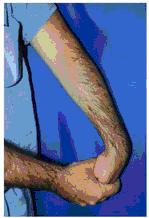Tennis Elbow (Lateral Epicondylitis)
Tennis elbow is a degenerative condition of the tendon fibers that attach on the bony prominence (epicondyle) on the outside (lateral side) of the elbow. The tendons involved are responsible for anchoring the muscles that extend or lift the wrist and hand.
Chronic overuse leads to tendon degeneration, which is painful.
Cause
Tennis elbow happens mostly in patients between 30 years and 50 years of age. It can occur in any age group.
Tennis elbow can affect as many as half of athletes in racquet sports. However, most patients with tennis elbow are not active in racquet sports. Most of the time, there is not a specific traumatic injury before symptoms start.
Many individuals with tennis elbow are involved in work or recreational activities that require repetitive and vigorous use of the forearm muscle. Some common activities that lead to epicondylitis include:
- Recreational: Tennis (groundstrokes), racquetball, squash, fencing
- Occupational: Meat cutting, plumbing, painting, raking, weaving
Some patients develop tennis elbow without any specific recognizable activity leading to symptoms.
Common activities that lead to epicondylitis are both recreational (tennis, especially groundstrokes; racquetball; squash; and fencing) and occupational (meat cutting, plumbing, painting, raking, and weaving).
Symptoms
Patients often complain of severe, burning pain on the outside part of the elbow. In most cases, the pain starts in a mild and slow fashion. It gradually worsens over weeks or months.
The pain can be made worse by pressing on the outside part of the elbow or by gripping or lifting objects. Lifting even very light objects (such as a small book or a cup of coffee) can lead to significant discomfort.
In more severe cases, pain can occur with simple motion of the elbow joint. Pain can radiate to the forearm.
Diagnosis
The diagnosis of tennis elbow begins with a complete medical history.
There will be a full physical examination.
- The sports medicine expert may press directly on the bony prominence on the outside part of the elbow to see if it causes pain.
- The sports medicine expert may also ask you to lift the wrist or fingers against pressure to see if that causes pain.
X-rays are not necessary. Rarely, magnetic resonance imaging (MRI) scans may be used to show changes in the tendon at the site of attachment onto the bone.
Treatment
Nonsurgical Treatment
In most cases, nonsurgical treatment is be tried before surgery.
Pain relief is the main goal in the first phase of treatment.
- You will betold to stop any activities that cause symptoms.
- You may need to apply ice to the outside part of the elbow.
- You may need to take acetaminophen or an anti-inflammatory medication for pain relief.
Orthotics can help diminish symptoms of tennis elbow. You will use counterforce braces and wrist splints. These can reduce symptoms by resting the muscles and tendons.

Left, counterforce brace. Right, wrist brace.
Symptoms should improve significantly within four weeks to six weeks.
If symptoms do not improve, the next step is a corticosteroid injection around the outside of the elbow. This can be very helpful in reducing pain. Corticosteroids are relatively safe medications. Most of their side effects (i.e., further degeneration of the tendon and wasting of the fatty tissue below the skin) occur after multiple injections. Avoid repeated injections (more than two or three in a specific site).

Wrist stretching exercise with elbow extended.
After pain is relieved, the next phase of treatment starts. Modifying activities can help make sure that symptoms do not come back. The sports medicine specialist will want you to do physical therapy. This may include stretching and range of motion exercises and gradual strengthening of the affected muscles and tendons (see figure right). Physical therapy can help complete recovery and give you back a painless and normally functioning elbow. Nonsurgical treatment is successful in approximately 85 percent to 90 percent of patients with tennis elbow.
Surgical Treatment
Surgery is considered only in patients who have incapacitating pain that does not get better after at least six months of nonsurgical treatment.
The surgical procedure involves removing diseased tendon tissue and reattaching normal tendon tissue to bone (figure below). The procedure is an outpatient surgery, not requiring an overnight stay in the hospital. It can be performed under regional or general anesthesia.
- Most commonly, the surgery is performed through a small incision over the bony prominence on the outside of the elbow.
- Recently, an arthroscopic surgery method has been developed.
Rehabilitation
After surgery, the elbow is placed in a small brace and the patient is sent home. About one week later, the sutures and splint are removed. Then exercises are started to stretch the elbow and restore range of motion. Light, gradual strengthening exercises are started two months after surgery.
The Sports medicine expert will tell you when you can return to athletic activity. This is usually approximately four months to six months after surgery. Tennis elbow surgery is considered successful in approximately 80 percent of patients.
